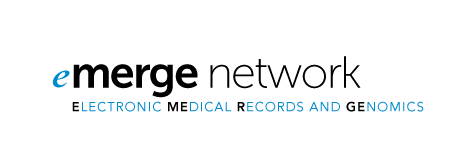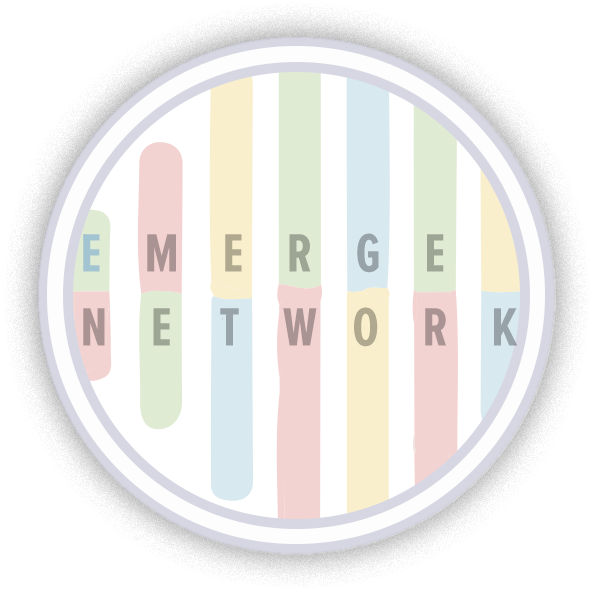Welcome to eMERGE’s “Frequently Asked Questions” page.
Click on each question below to expand and learn more about each topic:
What is the eMERGE Network?
The Electronic Medical Records and Genomics (eMERGE) Network is a National Human Genome Research Institute (NHGRI)-funded consortium tasked with developing methods and best practices for utilization of the electronic medical record (EMR) as a tool for genomic research. Now in its fourth funding cycle, eMERGE has made a significant impact on the medical health profession. Ultimately, eMERGE hopes its efforts will result in improvements in health care, through safer and more effective prescription methodology, augmentation of primary and secondary prevention strategies, and enhanced understanding of the biology of disease.
What are eMERGE’s aims?
-
- Calculate validated polygenic risk scores (PRS) for several complex diseases.
- Communicate genomic risk profiles and relevant clinical recommendations based on PRS, family history, and other clinical data.
- Recruit and genotype 25,000 individuals of diverse ancestry, prospectively calculate their genomic risk for selected conditions & return risk estimates and management recommendations to participants and providers.
- Assess uptake of risk-reduction recommendations and impact on related clinical outcomes.
What are eMERGE’s goals?
- Develop new technologies and allow for discoveries in genomic medicine.
- Deliver discoveries and results to patients and providers nationwide for improved diagnosis, medication selection, and risk factor modification.
How is eMERGE organized?
- The Steering Committee, which is comprised of site investigators, the central sequencing and genomic centers, the Coordinating Center and NHGRI staff. This group meets three times annually. Click here to view the leadership chart.
- Seven workgroups comprised of university faculty and medical professionals from across the nation.
- A seven-member External Scientific Panel, which provides independent input to the NHGRI about Network progress and future directions. Meets annually with the eMERGE Steering Committee, as well as annually via phone.
The eMERGE Network is comprised of which institutions?
The eMERGE Network is comprised of 10 sites. Each site maintains its own biorepository where DNA specimens are linked to phenotypic data contained within EMRs. Learn more about eMERGE sites here.
- Children’s Hospital of Pennsylvania, PI: Hakon Hakonarson, MD, PhD
- Cincinnati Children’s Medical Center, PIs: Lisa Martin, PhD; Leah Kottyan, PhD
- Columbia University, PIs: Wendy Chung, PhD, MS; George Hripcsak, MD, MS; Krzysztof Kiryluk, MD; Chunhua Weng PhD, MS
- Icahn School of Medicine at Mt. Sinai, PIs: Noura Abul-Husn, MD, PhD; Eimear Kenny, PhD;
- Mass General Brigham, PIs: Elizabeth Karlson, MD; Shawn Murphy, MD, PhD; Jordan Smoller, MD, ScD;
- Mayo Clinic, PIs: Richard Sharp, PhD
- Northwestern University, PIs: Rex Chisholm, PhD; Elizabeth McNally, MD ,PhD; Laura Rasmussen-Torvik, PhD
- University of Alabama at Birmingham, PIs: James Cimino, PhD; Nita Limdi Pharm.D, PhD, MSPH, FAHA
- University of Washington, PIs: David Crosslin, PhD; Gail Jarvik, MD, PhD
- Vanderbilt University, PIs: Dan Roden, MD; Digna Velez Edwards PhD, MS; Wei-Qi Wei MD, PhD
- Vanderbilt University serving as the Coordinating Center PI: Josh Peterson, MD, MPH and Broad Institute PI: Niall Lennon, PhD
eMERGE Site Participation by Phase
eMERGE Phase IFounded in September 2007 with five network sites:
* Kaiser Permanente Washington Health Research Institute (formally Group Health)/University of Washington
* Marshfield Clinic
* Mayo Clinic
* Northwestern University
* Vanderbilt University (also coordinating center)Phase I Workgroups:
* Consent and Community Consultation Workgroup – Published model consent language for EMR-linked biorepositories Intended to harmonize the consent process for the collection and storage of human biospecimens and data for future research, particularly those collections that have an EMR component.
* Genomics Workgroup – Created a unified data set of genotyped samples across all sites, and published a “how to” paper that outlined the procedures and lessons learned from combining genotype data across a research network
* Informatics Workgroup – Created and published a library of EMR-based phenotyping algorithms accrued throughout Phase I that is available to investigators outside of the eMERGE Network
eMERGE Phase II
In addition to previously established eMERGE sites, the network gained four new sites in 2011, two adult and two pediatric:
* Geisinger
* Icahn School of Medicine at Mount Sinai
* Children’s Hospital of Philadelphia
* Cincinnati Children’s Hospital Medical Center and Boston Children’s Hospital (joint site)
New workgroups were also created based on network aims:
* EHR Integration
* Return of Results
* eMERGE PGx
* Consent, Education, Regulation, and Consultation (previously Consent and Community Consultation)
* Phenotyping (previously Informatics)
* Pediatrics
* Genomics (same as Phase I)
eMERGE Phase III
The Network gained four sites in 2015
* Columbia University
* Harvard University
* Baylor College of Medicine (CSG)
* Partners/Broad (CSG)Three sites from Phase II became non-member affiliated partners
* Marshfield Clinic/Essential Rural Health
* Icahn School of Medicine at Mount Sinai
* Boston Children’s Hospital
New Workgroups were created based on network aims and goals
* Clinical Variant Annotation
* Outcomes
eMERGE Phase IV
The Network gained one site in 2020
* University of Alabama at Birmingham
New Workgroups were created based on network aims and goals
* PRS Validation & Evaluation
*Genotyping
*Comprehensive Risk Assessment & Return
*Recruitment, Retention, sIRB, ELSI
*EHR workflow & infrastructure
*Phenotyping
*Provider Uptakes & Outcomes
What are the workgroups and their goals?
Coming Soon
Frequently used terminology
- Algorithm: Step-by-step procedure that includes decision-free approaches to healthcare treatment (ex: if symptoms A, B, and C are evident, then use treatment X) and also less clear-cut tools aimed at reducing or defining uncertainty
- Allele: Alternate form of a gene or DNA Sequence.
- Annotation: Adding pertinent information such as ‘gene coded for,’ ‘amino acid sequence,’ or other commentary to the database entry of raw sequence DNA bases.
- Biobank: A type of biorepository that stores biological samples (usually human) for use in research.
- Bioinformatics: The collection, classification, storage, and analysis of biochemical and biological information using computers, especially as applied to molecular genetics and genomics.
- Biorepository: A biological materials repository that collects, processes, stores, and distributes biospecimens to support future scientific investigation.
- Chromosome: Structures found in the center (nucleus) of cells that carry long pieces of DNA.
- CPT Code: (Current Procedural Terminology) codes are numbers assigned to every task and service a medical practitioner may provide to a patient including medical, surgical, and diagnostic services. They are then used by insurers to determine the amount of reimbursement that a practitioner will receive by an insurer when he or she performs that service.
- EMR: (Electronic Medical Record) databases that contain the standard medical and clinical data gathered by medical care providers.
- Exome: The segment of the human genome formed by exons. The portions of a gene or genome that code information for protein synthesis.
- Genome: An organism’s complete set of DNA, including all of its genes. Each genome contains all of the information needed to build and maintain that organism. In humans, a copy of the entire genome is contained in all cells that have a nucleus.
- Genome-wide-association Study (GWAS): An approach that involves rapidly scanning markers across the complete sets of DNA, or genomes, of many people to find genetic variations associated with a particular disease. Once new genetic associations are identified, researchers can use the information to develop better strategies to detect, treat and prevent the disease.
- Genomics: The study of genes and their functions. Genomics aims to understand the structure of the genome, including the mapping of genes and sequencing of DNA. Genomics examines the molecular mechanisms and the interplay of genetic and environmental factors in disease.
- Genotype: The internally coded, inheritable information carried by all living organisms.
- Genotype-Phenotype Associations: The association between the presence of a certain mutation or mutations (genotype) and the resulting physical trait, abnormality, or pattern of abnormalities (phenotype).
- Genotyping: Testing that reveals the specific alleles inherited by an individual; particularly useful for situations in which more than one genotypic combination can produce the same clinical presentation, as in the ABO blood group, where both the AO and AA genotypes yield type A blood.
- Haplotype: The combination of linked marker alleles (may be polymorphisms or mutations) for a given region of DNA on a single chromosome.
- Heterogeneous: Composed of parts of different kinds.
- Homogeneous: Composed of parts or elements that are all of the same kind.
- ICD-9-CM: (The International Classification of Diseases, Ninth Revision, Clinical Modification) the official system of assigning codes to diagnoses and procedures associated with hospital utilization in the United States.
- Locus (loci): The physical site on a chromosome occupied by a particular gene or other identifiable DNA sequence characteristic
- Natural Language Processing: (NLP) is a branch of artificial intelligence that deal with analyzing, understanding and generating the languages that humans use naturally in order to interface with computers in both written and spoken contexts using natural human languages instead of computer languages.
- Personalized Medicine: Tailoring of medical treatment to the individual characteristics, needs, and preferences of a patient during all stages of care, including prevention, diagnosis, treatment, and follow-up. ‘The right patient with the right drug at the right dose at the right time.’
- Pharmacogenomics: The study of how a person’s genes affect the way he or she responds to drugs. It is being used to learn ahead of time what the best drug or the best dose of a drug will be for a person.
- Phenotype: The outward, physical manifestation of an organism.
- Phenotyping: The study of an organism’s observable characteristics and traits to make genetic associations with the goal of discovering links between genes and diseases.
- SNP: (Single Nucleotide Polymorphism) is a variation at a single position in a DNA sequence among individuals. Recall that the DNA sequence is formed from a chain of four nucleotide bases: A, C, T, G. If more than 1% of a population does not carry the same nucleotide at a specific position in the DNA sequence, then this variation can be classified as a SNP. IF a SNP occurs within a gene, then the gene is described as having more than one allele. In these cases, SNPs may lead to variations in the amino acid sequence. SNPs, however, are not just associated with genes; they can also occur in noncoding regions of DNA. Although a particular SNP may not cause a disorder, some SNPs are associated with certain diseases. These associations allow scientists to look for SNPs in order to evaluate an individual’s genetic predisposition to develop a disease. In addition, if certain SNPs are known to be associated with a trait, then scientists may examine stretches of DNA near these SNPs in an attempt to identify the gene or genes responsible for the trait.
Informative publications
- Returning integrated genomic risk and clinical recommendations: The eMERGE study
- Parental attitudes toward consent and data sharing in biobanks: a multi-site experimental survey
- Ethical considerations related to return of results from genomic medicine projects: the eMERGE Network (Phase III) experience
- Harmonizing clinical sequencing and interpretation for the eMERGE-3 Network
- Returning genomic results to eMERGE participants: The who, what, where, and how of disclosure
- Harmonizing outcomes for genomic medicine: comparison of eMERGE outcomes to ClinGen outcome/intervention pairs
- Healthcare provider education to support integration of pharmacogenomics in practice: the eMERGE Network experience
- OMOP Information Model for Phenotyping
- Empowering genomic medicine by establishing critical sequencing result data flows: the eMERGE example

